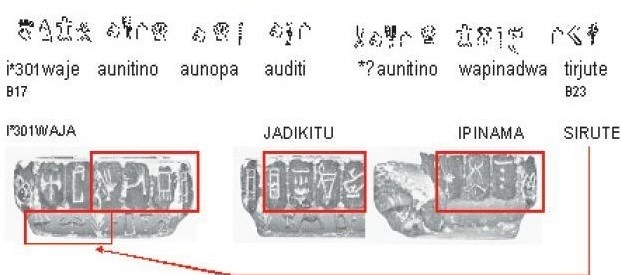PARALLEL TEXTS OF JUKTAS
The regulations of a ritual.
The parallel texts of Juktas. The virgin officiates.
They were found in the Minoan Sanctuary of Juktas, in Minoan Crete, Greece. It dates back to 1700 B.C..
The parallel texts, according to Gareth Owens, as they are depicted in the “View” («Άποψη») magazine, by Areti Alexopoulou, are the following:

The inscribed texts are identified and clearly written, according to the view of the International Academy of Ancestral Discourse.
α) I-(LI) – WA-JE AU- NI-TI-NO AU- NO-PA AU- DI-TI (HAR)- AU- NI-TI-NO WA PI-NA- DWA TI-RJU-TE.
β) I-(LI)- WA-JA SI-RU-TE JA-DI- KI-TU I-PI- NA-MA.
In the text we can find the rite of a religious ritual in the Minoan Times.
The text is a document of the rite of a religious ritual in the Sanctuaries of the time.
We studied the phonetic values in the actual text. We understood it, we read and rendered it into Modern Greek, but we also approached it philosophically.
Figuration of the phonetic values of the text.
In our own view, the phonetic values are formed as follows:
α) I(LLI) WAJE AU NITINO AU NOPA AU DITI (HAR) AU NITINO WA PINA DWA TIRJUTE.
β) I(LLI) WAJA SIRUTE JADI KITU IPI NAMA.
The language of the text is Greek, Archaic, typical of any Minoan text. The grammatical structure of the text is mixed.
One can identify Pontic words, as well as Classical Greek Language.
The utterance of the words and of the verbal types, follows the grammatical rules of the Pontic Dialect, as well as those of the Classical Greek Language.
Rendition of the text:
α) Ύλλει βαγεί αούτε νίτινον, αούτα νεωπά, αούτα διττήν. Χαρ αούτε νίτινον (βα)πα ποίνα φατυρυουτεί.
β) Ύλλει βαγιά σύρουτε γιάντι κοίτου υπίει ναμά.
The Τext in Modern Greek:
First Text:
The priestess sings hymns, during the praises she burns incense to the carcasses of the altar. They are raw and they are placed in two sides of the altar. Thus, according to the rite of the ritual, the priestess burns incense and I helped her, by lighting the place.
(Λέγει και ψέλνει ύμνους αυτή (η ιέρια), κατά τη διάρκεια των αίνων καίει θυμίαμα, σε αυτά τα προςτο θυσιαστήριο προσφερόμενα σφάγια. Είναι νωπά αυτά και σε δύο μέρη επί του βωμού τίθενται.Τώρα λοιπόν αυτή κατά το αινιτινόν τυπικόν καίει θυμίαμα και εγώ έκανα φάος (φώς), κατά τηντέλεση του τυπικού της τελετουργίας).
Second Text:
The priestess sings hymns until the carcasses get roasted, as they lie on the altar bleeding.
(Λέγει και ψέλνει ύμνους έως ότου τα σφάγια να τραβήξουν τα υγρά τους (να ψηθούν), γιατί κείτονταιαφημένα χαμηλά (κατάχαμα επί του βωμού) ρέοντα (αίματα)).
A Philosophical Approach:
The inscribed stones that came to light during excavations in the sanctuary of Juktas, in Minoan Crete, are an evidence of the Minoan ritual.
The role of the priestess on the altar is determining.
The priestess sings hymns and at the same time she burns incense on the altar.
She waits until cinder («ζάαρ») appears in the altar. Τhis means that it is time for sacrifice. She places the bleeding carcasses on the altar so that they dry off, before they are delivered to the worshippers for kourpan* (“κουρπάν”).
* kourpan: I serve everybody during the ritual and after it, a custom delivered to us by Sanni. I prepare the meals of the symposium, for those attending the sacrifices in the sanctuary.
During the ritual, a man holding a torch, accompanies and lights up the priestess.
The inscriptions on the stone demonstrate the ritual procedures of the past.
